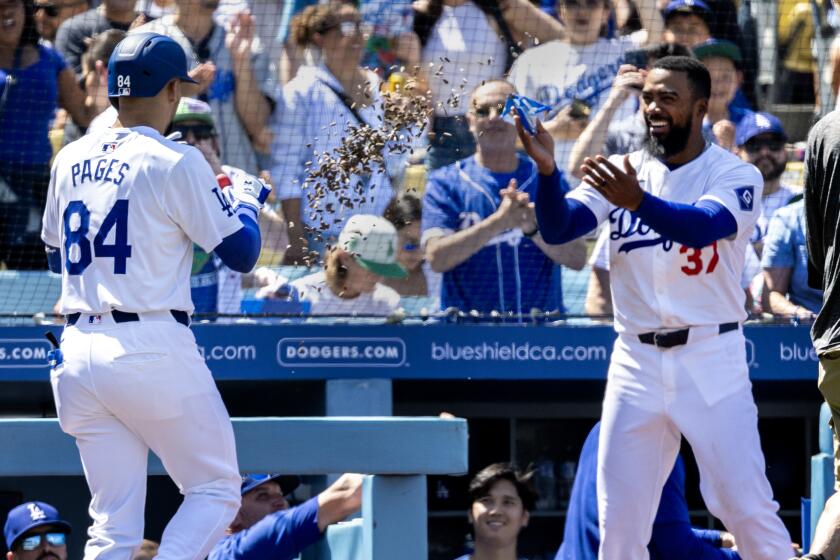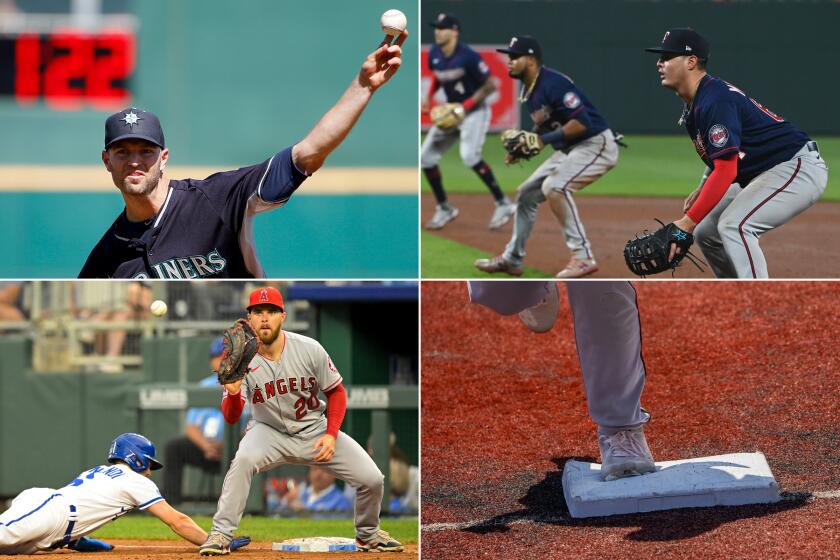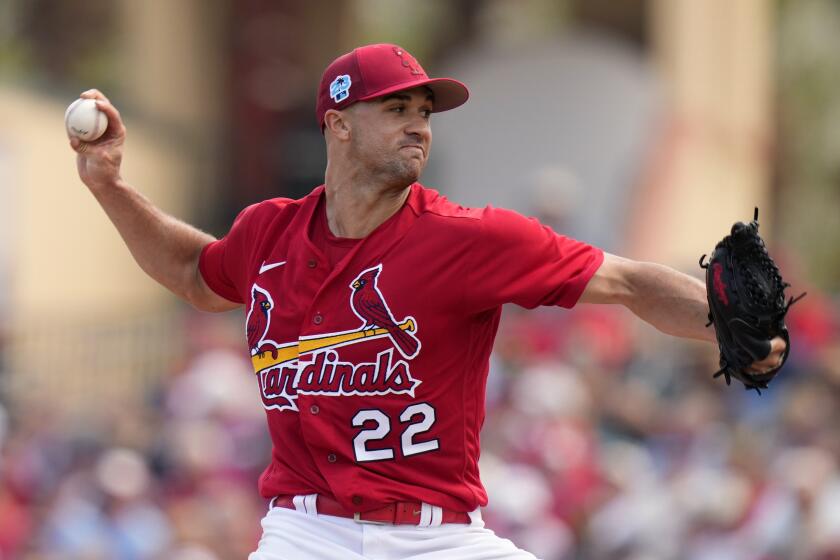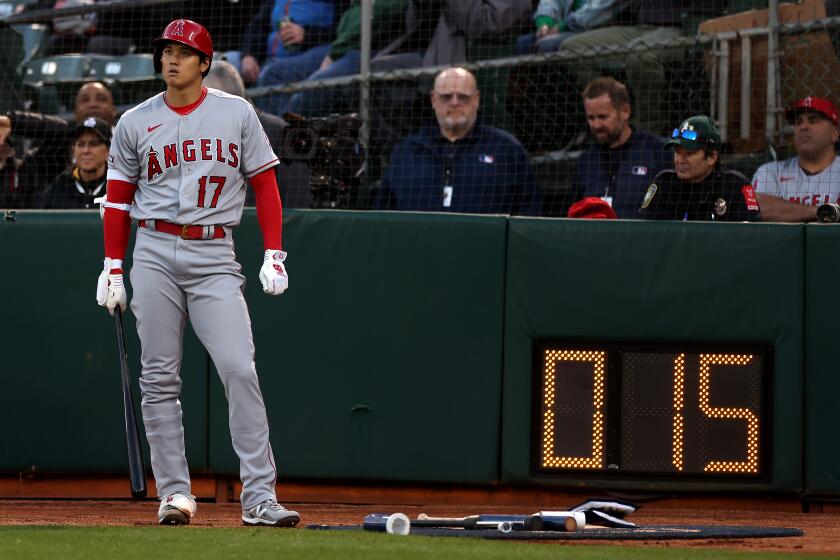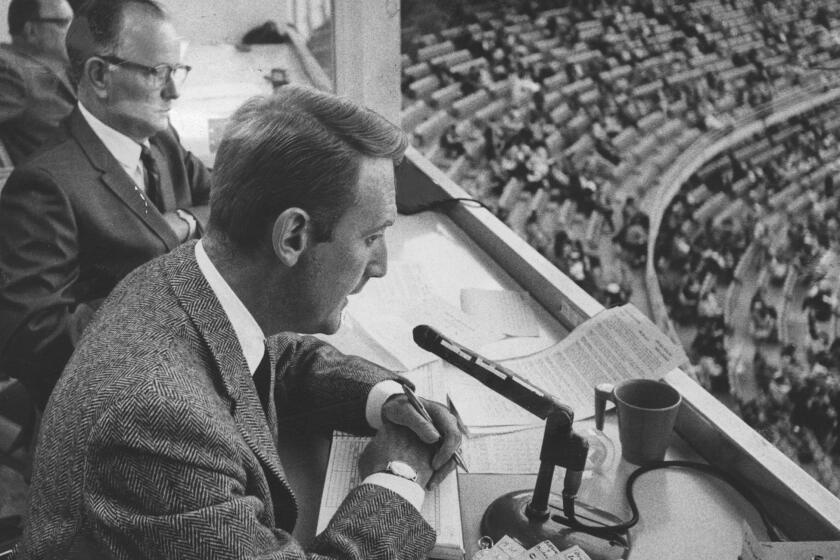Opinion: End the blows against the beauty of baseball
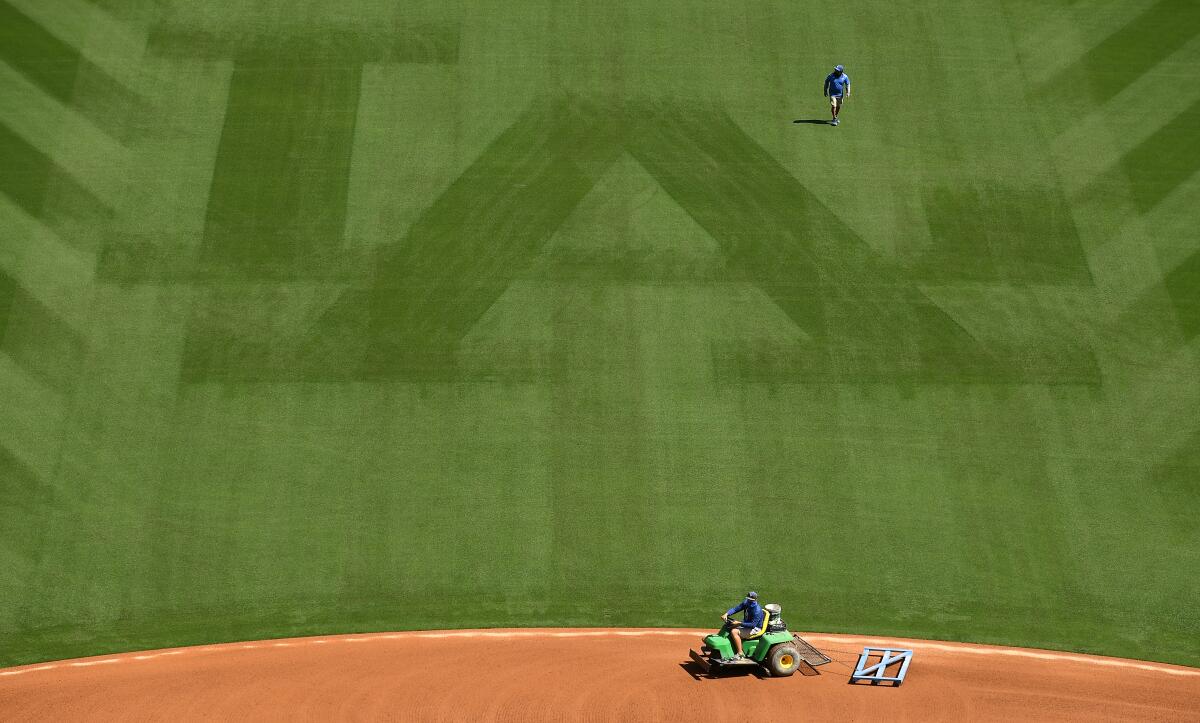
The following confession may come as a shock to those who know me: I am now a conservative. When it comes to baseball, that is.
I watched the blown check-swing call that allowed the Dodgers to win a game against the Rockies last month in an improbable comeback and to the fury of Colorado fans. The ump’s clear mistake will only add to demands that check-swing calls be included in the instant replay protocol.
But check-swing subjectivity is a fundamental part of the way baseball is supposed to function: humanly, in sublime, sometimes maddening imperfection. MLB interventions to “fix” it — larger bases, the ghost runner at second base in extra innings, batters limited to one timeout per at-bat and, worst of all, the pitch clock — are blows against the beauty of the game.
Teoscar Hernández has helped elevate the mood in the Dodgers’ dugout with his unique celebrations and his reputation for delivering in clutch moments.
Admittedly, these changes seem to be quite popular. Games had been running longer and longer with incessant pitching changes, dawdling batters and, yes, replay reviews. But what monstrous hubris to think we know better than baseball’s Original Framers! Ninety feet between bases, 60 feet, 6 inches between pitching rubber and home plate — these are divinely induced measurements. Start messing with tradition and the heart of the game is lost to hyper-regulated “reality.”
Baseball is not reality. It is myth performed by real bodies. And imperfection, which is also the unexpected, beyond the reach of metrics, is where the magic comes from — magical triumph and magical heartbreak, larger than life, operatic.
There is no doubt that soccer is the “beautiful game,” but baseball gives it a run for its money. Its own beauty has resulted from the gradual accrual of tradition, which has given us a poetics.
A pitch clock, pickoff limit, the changing of shifts on defense and bigger bases could make for a different game in the upcoming season.
Languor is one of baseball’s essential characteristics. Seemingly nothing happens for long minutes; no one scores, no “bang-bang” double plays, just lazy fly balls and dribbled grounders; you are swayed by the lullaby of sun and beer into a somnambulant state.
And then “just like that,” as Vin Scully used to say, there’s a majestic home run blast, a leaping catch, a fierce duel between pitcher and batter, a spectacular strikeout. The explosion of affect is all the more powerful for having emerged so suddenly from the caesura. (Soccer fans experience a version of these symphonic changes of tempo on the pitch.)
Baseball’s temporality is inseparable from its physical dimensions, the space-time of the game. The vast swath of grass between outfielders, the closer quarters of the infielders, the tunnel of focus that connects pitcher, batter, catcher and umpire.
To a baseball purist, the idea of timing pitchers and batters was anathema at first. Then I went to spring training.
The imperfection of umpires is indispensable in the gestalt. Video appeals rob us of the opportunity to yell at the ump to get glasses, or suffer much worse things. A blown call can lead to simultaneous jubilation and heartbreak, with the losers rending their garments and smarting from the insult of being “robbed.”
All as it should be.
I say: Bring back smaller bags and keep stealing a base a rare art! I say: No more ghost runner (what did he do to deserve to be there?) and go on all night with punch-drunk players if that’s what the game demands. And most of all I say: Smash the pitch clock with an Adirondack bat. The timer is an abomination under baseball heaven, depriving us of the organic crescendo of tension in an epic at-bat in the late innings of a close World Series game (Kirk Gibson, 1988).
The pitch clock is winning over players and fans while it’s making baseball more fun and exciting. MLB might have saved itself with the concept.
When I interviewed Scully after the Los Angeles riots-uprising of 1992, I asked him what he‘d said on the air about the chaos unfolding that first night, as a game was underway at Dodger Stadium. “I didn’t say a word,” he told me. He thought first of his responsibility to the fans and their safety — what if he caused panic? And he added: “There should be one place left where the rest of the world doesn’t intrude.”
He might as well have said baseball is sacred. Not to be messed with. Not even (as if it were possible) by history itself.
On all this, I come down as far more conservative than, say, old-school, bow-tied traditionalist George Will, who for once approves of the “progressive” in the form of the new rules he thinks augur a return of baseball to its one-time status as national pastime. The game, awash in play-by-metrics, Will has argued, is bloated not by poetic languor but by analytical ennui.
In the summer of ‘61, Vin Scully talked about the weather, about the gathering twilight, about the history of the baseball, about nothing really that important. But sometimes talking about nothing really that important speaks something into being.
True that, Mr. Will. We agree about baseball’s slow death-by-numbers. At the end of the day, all the measurements miss the point — the ineffable beauty of a summer afternoon ever so slowly turning to night at the ballpark.
Some of us know when a cure is worse than the disease.
There is a reason baseball was famously the preferred sport of American literati in the mid-20th century. And the pitch clock wasn’t part of the poetry.
Rubén Martínez is a literature professor at Loyola Marymount University, the author of numerous books and co-creator and executive producer of the performance piece “Little Central America, 1984.”
More to Read
A cure for the common opinion
Get thought-provoking perspectives with our weekly newsletter.
You may occasionally receive promotional content from the Los Angeles Times.
